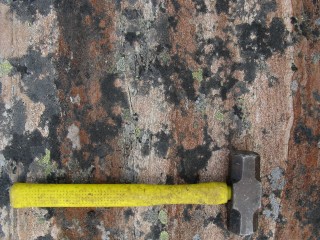Isotopic Memory of Atmospheric Persistence

Boswell Wing, McGill University Rocks of the Ujaraaluk unit of the Nuvvuagittuq Greenstone Belt
Chemical analysis of some of the world’s oldest rocks, by an international team led by McGill University researchers, has provided the earliest record yet of Earth's atmosphere. The results show that the air 4 billion years ago was very similar to that more than a billion years later, when the atmosphere — though it likely would have been lethal to oxygen-dependent humans — supported a thriving microbial biosphere that ultimately gave rise to the diversity of life on Earth today.
The findings, published last week in the Proceedings of the National Academy of Sciences, could help scientists better understand how life originated and evolved on the planet. Until now, researchers have had to rely on widely varying computer models of the earliest atmosphere's characteristics.
The new study builds on previous work by former McGill PhD student Jonathan O’Neil (now an assistant professor at Ottawa University) and McGill emeritus professor Don Francis, who reported in 2008 that rocks along the Hudson Bay coast in northern Quebec, in an area known as the Nuvvuagittuq Greenstone Belt, were deposited as sediments as many as 4.3 billion years ago — a couple of hundred million years after the Earth formed.
In the new study, a team led by researchers from McGill’s Earth and Planetary Sciences Department, used mass spectrometry to measure the amounts of different isotopes of sulfur in rocks from the Nuvvuagittuq belt. The results enabled the scientists to determine that the sulfur in these rocks, which are at least 3.8 billion years old and possibly 500 million years older, had been cycled through the Earth's early atmosphere, showing the air at the time was extremely oxygen-poor compared to today, and may have had more methane and carbon dioxide.
“We found that the isotopic fingerprint of this atmospheric cycling looks just like similar fingerprints from rocks that are a billion to 2 billion years younger,” said Emilie Thomassot, a former postdoctoral researcher at McGill and lead author of the paper. Emilie Thomassot is now with the Centre de Recherches Pétrographiques et Géochimiques (CRPG) in Nancy France.
“Those younger rocks contain clear signs of microbial life and there are a couple of possible interpretations of our results,” says Boswell Wing, an associate professor at McGill and co-author of the new study. “One interpretation is that biology controlled the composition of the atmosphere on early Earth, with similar microbial biospheres producing the same atmospheric gases from Earth’s infancy to adolescence. We can’t rule out, however, the possibility that the biosphere was decoupled from the atmosphere. In this case geology could have been the major player in setting the composition of ancient air, with massive volcanic eruptions producing gases that recurrently swamped out weak biological gas production.”
The research team is now extending its work to try to tell whether the evidence supports the “biological” or the “geological” hypothesis — or some combination of both. In either case Emilie Thomassot says, the current study “demonstrates that the Nuvvuagittuq sediments record a memory of Earth’s surface environment at the very dawn of our planet. And surprisingly, this memory seems compatible with a welcoming terrestrial surface for life”. The team is now extending their investigation to early Archean sediments from other localities in Canada, such as the Labrador coast (see www.saglek-expedition.org).
The research was supported by the Natural Sciences and Engineering Research Council of Canada and the Canadian Space Agency, and by France’s Lorraine region and the Centre National de la Recherche Scientifique.
“Atmospheric record in the Hadean Eon from multiple sulfur isotope measurements in Nuvvuagittuq Greenstone Belt (Nunavik, Quebec)” E. Thomassot, J. O’Neil, D. Francis, P. Cartigny, B. A. Wing. Proceedings of the National Academy of Sciences, published online Jan. 5, 2015.
www.pnas.org/cgi/doi/10.1073/pnas.1419681112
Contact Information
Cynthia Lee
cynthia.lee@mcgill.ca
Media Contact
More Information:
http://www.mcgill.caAll latest news from the category: Earth Sciences
Earth Sciences (also referred to as Geosciences), which deals with basic issues surrounding our planet, plays a vital role in the area of energy and raw materials supply.
Earth Sciences comprises subjects such as geology, geography, geological informatics, paleontology, mineralogy, petrography, crystallography, geophysics, geodesy, glaciology, cartography, photogrammetry, meteorology and seismology, early-warning systems, earthquake research and polar research.
Newest articles

“Nanostitches” enable lighter and tougher composite materials
In research that may lead to next-generation airplanes and spacecraft, MIT engineers used carbon nanotubes to prevent cracking in multilayered composites. To save on fuel and reduce aircraft emissions, engineers…

Trash to treasure
Researchers turn metal waste into catalyst for hydrogen. Scientists have found a way to transform metal waste into a highly efficient catalyst to make hydrogen from water, a discovery that…

Real-time detection of infectious disease viruses
… by searching for molecular fingerprinting. A research team consisting of Professor Kyoung-Duck Park and Taeyoung Moon and Huitae Joo, PhD candidates, from the Department of Physics at Pohang University…




















